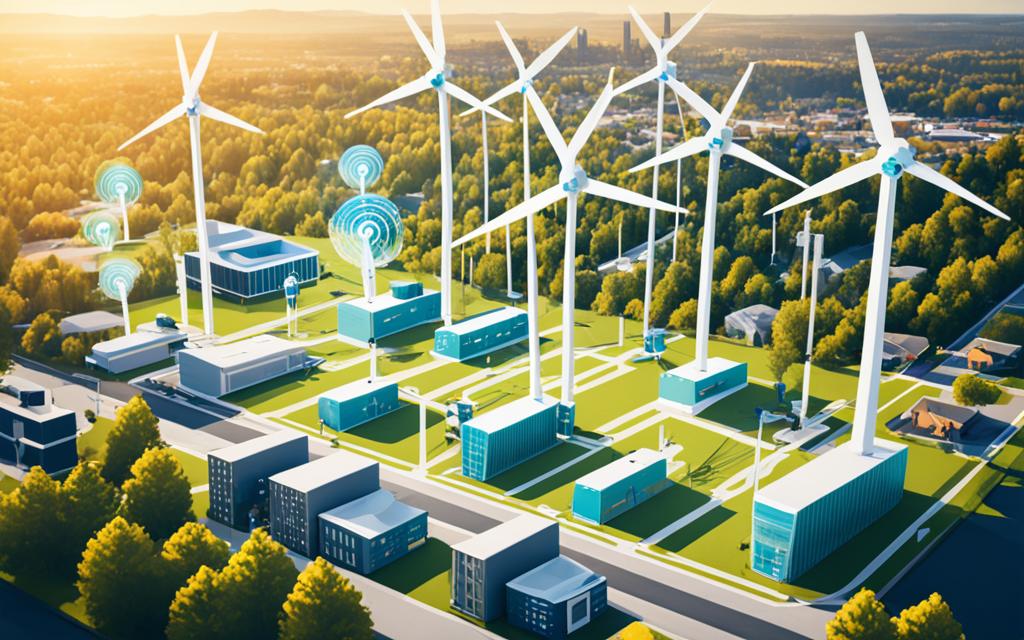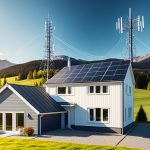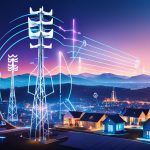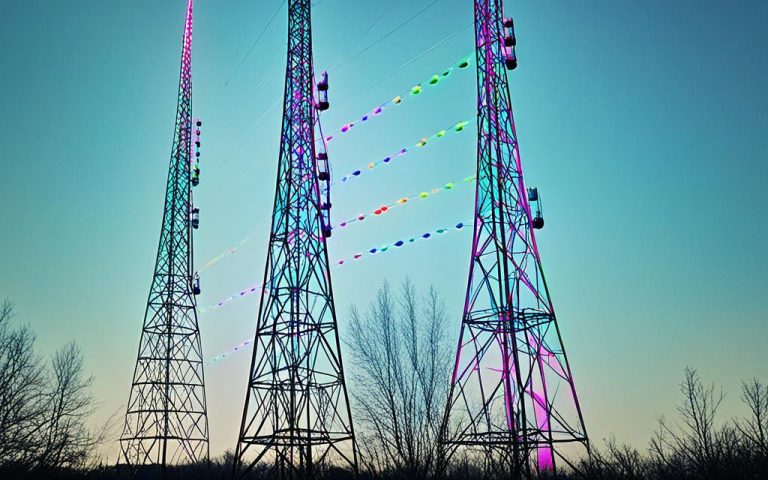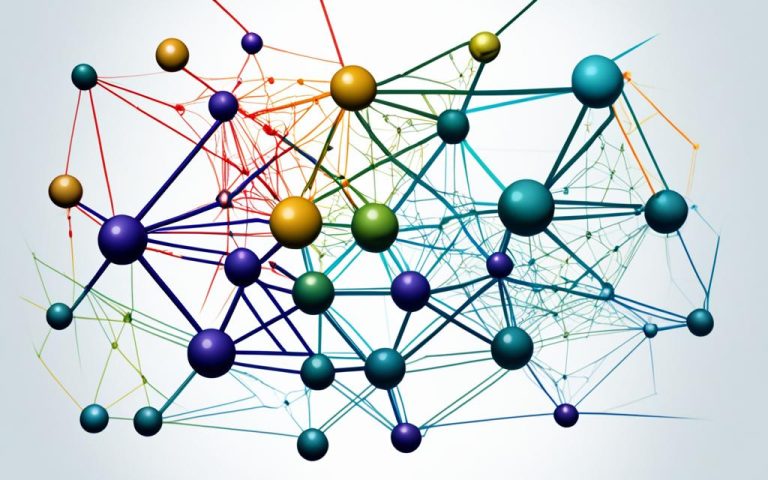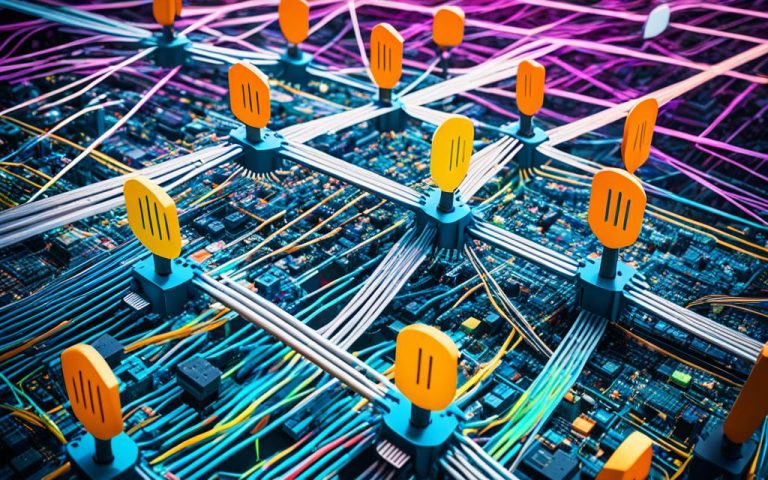Fixed wireless access (FWA) is the latest generation of wireless network technology, offering higher transmission rates, more reliable connectivity, and lower latency. In this article, we will explore the economic impact of deploying FWA as part of 5G networks. By examining the FWA economics, we can understand the deployment benefits and the positive effects it has on various sectors of the economy.
The Importance of 5G for Economic Development
5G, along with other forms of broadband, plays a crucial role in driving economic growth in the United States. Private investment in broadband infrastructure contributes directly to GDP. Since 1996, broadband providers have invested over $1.7 trillion in private capital expenditure.
The deployment of 5G networks will create additional jobs and increase wages in the labor market. According to the analysis in the report, it is estimated that 8.5 million jobs will be created over 2019-2025 compared to a counterfactual 4G-only world. This translates to an average of 1.2 million new jobs each year.
These workers will earn more than $560 billion during that time, create $1.7 trillion in additional output, and add over $900 billion to U.S. GDP.
It is clear that the economic impact of 5G goes beyond just the expansion of connectivity. It has the potential to drive economic development, create employment opportunities, and contribute significantly to the overall growth of the nation.
The Potential of 5G for Businesses and Consumers
5G networks offer significant benefits for both businesses and consumers. With the advent of 5G, the Internet of Things (IoT) has gained increased momentum, enabling businesses to improve productivity and gain a competitive advantage. The higher capacity and lower latency of 5G networks allow for faster and more reliable transmission of data, paving the way for innovation in various sectors.
One of the key areas where 5G and IoT hold immense potential is healthcare. The increased connectivity and improved data transmission speeds enable the development of advanced healthcare devices that can remotely monitor patients, provide real-time diagnostics, and enable telemedicine. This not only enhances patient care but also expands access to healthcare services, especially in remote areas.
Autonomous vehicles are another area that stands to benefit from 5G. The low latency and high-speed connectivity of 5G networks enable seamless communication between autonomous vehicles and their surrounding environment, ensuring safer and more efficient transportation. Additionally, smart home technology is set to revolutionize the way we live and interact with our surroundings. With 5G, homeowners can expect faster and more reliable connectivity for their smart devices, allowing for enhanced automation and control over their homes.
Wearable devices, another rapidly growing market, will also see significant advancements with the advent of 5G. The higher bandwidth and lower latency of 5G networks enable more sophisticated wearable technology, transforming the way we track our health, monitor fitness levels, and interact with our devices. Consumers can expect faster and more accurate data synchronization, leading to improved user experiences and a wider range of applications.
In summary, the true promise of 5G and IoT lies in the ability to do completely new things using mobile and fixed wireless and IoT technology devices. From healthcare to transportation to smart home technology, the possibilities are vast and exciting for both businesses and consumers.
Moreover, the benefits of 5G extend beyond specific industries. The overall consumer value is immense, as people can expect peak mobile broadband transmission speeds of about 10 to 20 times faster than 4G LTE. This translates to faster downloads, smoother streaming, and quicker access to online services. The increased reliability and capacity of 5G networks open up possibilities for new services and experiences that were previously unavailable.
To highlight the potential of 5G for businesses and consumers, below is a table summarizing the key benefits:
| Benefits | Explanation |
|---|---|
| Enhanced Connectivity | 5G networks offer faster and more reliable connectivity, enabling seamless communication between devices and improved user experiences. |
| Advanced IoT Applications | The increased capacity and lower latency of 5G networks pave the way for innovative IoT applications, enhancing productivity and creating new business opportunities. |
| Improved Healthcare | 5G enables the development of advanced healthcare devices and remote monitoring systems, expanding access to quality healthcare services. |
| Transformative Transportation | The low latency and high-speed connectivity of 5G networks enable more efficient and safer transportation through seamless communication between autonomous vehicles and their surroundings. |
| Smart Home Automation | 5G provides faster and more reliable connectivity for smart home devices, allowing for enhanced automation, convenience, and control. |
| Innovative Wearable Technology | 5G enables more sophisticated wearable devices with faster and more accurate data synchronization, enhancing user experiences and expanding the range of applications. |
The potential of 5G for businesses and consumers is immense. From enabling transformative technologies in various industries to providing faster and more reliable connectivity for everyday tasks, 5G brings numerous benefits and opportunities. As the deployment of 5G networks continues, businesses and consumers alike can look forward to a future of enhanced connectivity and innovative applications.
Unlocking Economic Development in Rural Areas
5G networks have the potential to bring significant economic development to rural and economically disadvantaged areas. These networks can bridge the digital divide, expand labor and output markets, and provide access to essential services like healthcare and education.
“5G networks hold particular promise for economic development in rural areas, where access to high-speed internet and advanced telecommunications infrastructure is often limited. By deploying 5G networks in these areas, we can unlock new opportunities and drive economic growth.”
The deployment of 5G networks in cities such as Los Angeles, New York, Pittsburgh, and Roanoke has already demonstrated positive economic impacts. Case studies highlighted in the report showcase how the construction of 5G networks, coupled with consumer spending on 5G-enabled devices and services, creates significant job opportunities in these cities.
The report estimates that about 250,000 jobs will be created in Los Angeles, up to 120,000 jobs in New York City, approximately 22,000 jobs in Pittsburgh, and around 2,700 jobs in Roanoke. These employment opportunities span across various sectors, including infrastructure development, telecommunications, and the production of 5G devices and equipment.
Enhancing Connectivity and Empowering Communities
By bringing 5G to rural areas, we can unleash the full potential of these communities. High-speed internet access enables businesses to thrive, attracting new industries and creating employment opportunities for local residents. Improved connectivity also enables access to online education and telemedicine, enhancing the quality of life and empowering individuals in rural areas to participate fully in the digital economy.
Furthermore, bridging the digital divide through 5G deployment ensures that no community is left behind in the digital age. It promotes equal access to information, services, and opportunities, leveling the playing field and fostering inclusive economic development.
Unlocking the Power of 5G for Rural America
As the world becomes increasingly interconnected, it is vital that rural areas are not left behind in the digital revolution. 5G networks have the potential to transform these areas, driving economic development, reducing inequality, and improving the lives of millions.
| City | Estimated Jobs Created |
|---|---|
| Los Angeles | 250,000 |
| New York City | 120,000 |
| Pittsburgh | 22,000 |
| Roanoke | 2,700 |

As 5G continues to expand and reach rural areas, it is essential to prioritize investment in the necessary infrastructure and ensure that the economic benefits are shared by all. By unlocking the power of 5G, we can bridge the digital divide, create employment opportunities, and propel rural America into a prosperous and connected future.
Conclusion
Based on the economic analysis of Fixed Wireless Access (FWA) deployment within 5G networks, it is evident that the investment needed to deploy 5G infrastructure will have significant economic implications. This investment will not only contribute directly to GDP but also create millions of jobs. Businesses and consumers will reap the benefits of improved connectivity and new opportunities that 5G networks bring. Moreover, the deployment of 5G has the potential to drive economic development in rural and economically disadvantaged areas by bridging the digital divide and providing access to essential services.
As the deployment of 5G continues, it becomes crucial to closely analyze the economic impact and ensure that these benefits reach all segments of society. By leveraging FWA as part of 5G networks, we can expect a boost in economic growth, job creation, and improved connectivity across various industries and regions. It is important that policymakers, governments, and stakeholders collaborate to maximize the potential of 5G deployment benefits and create a more inclusive and prosperous digital future.
Through careful economic analysis and strategic investments, the deployment of FWA in 5G networks presents a unique opportunity to enhance the overall economic landscape. As technology evolves, it is essential to stay informed about the economic impacts and harness the potential of 5G to drive innovation, productivity, and sustainable economic development.
FAQ
What is fixed wireless access (FWA)?
Fixed wireless access (FWA) is the latest generation of wireless network technology that offers higher transmission rates, more reliable connectivity, and lower latency.
What are the economic implications of deploying 5G networks?
The deployment of 5G networks, which include FWA, will have significant economic implications. A report estimates that 5 billion in capital expenditure will be needed over the next seven years to fully deploy 5G, contributing directly to GDP and resulting in the creation of 8.5 million jobs over 2019-2025.
How does 5G contribute to economic growth in the United States?
Private investment in broadband infrastructure, including 5G networks, directly contributes to GDP. Since 1996, broadband providers have invested over
FAQ
What is fixed wireless access (FWA)?
Fixed wireless access (FWA) is the latest generation of wireless network technology that offers higher transmission rates, more reliable connectivity, and lower latency.
What are the economic implications of deploying 5G networks?
The deployment of 5G networks, which include FWA, will have significant economic implications. A report estimates that $225 billion in capital expenditure will be needed over the next seven years to fully deploy 5G, contributing directly to GDP and resulting in the creation of 8.5 million jobs over 2019-2025.
How does 5G contribute to economic growth in the United States?
Private investment in broadband infrastructure, including 5G networks, directly contributes to GDP. Since 1996, broadband providers have invested over $1.7 trillion in private capital expenditure. The deployment of 5G networks is projected to create 8.5 million jobs over 2019-2025, increasing wages and adding over $900 billion to U.S. GDP.
What benefits do 5G networks offer for businesses and consumers?
5G networks offer significant benefits for both businesses and consumers. The increased capacity and lower latency of 5G allow for faster and more reliable transmission of data, enabling businesses to improve productivity and gain a competitive advantage. Consumers can expect peak mobile broadband transmission speeds of about 10 to 20 times faster than 4G LTE, opening up possibilities for new services and experiences.
How can 5G contribute to economic development in rural areas?
5G networks hold promise for economic development in rural and economically disadvantaged areas. These networks can expand labor and output markets, fill gaps in existing broadband coverage, and provide access to essential services such as healthcare and education.
.7 trillion in private capital expenditure. The deployment of 5G networks is projected to create 8.5 million jobs over 2019-2025, increasing wages and adding over 0 billion to U.S. GDP.
What benefits do 5G networks offer for businesses and consumers?
5G networks offer significant benefits for both businesses and consumers. The increased capacity and lower latency of 5G allow for faster and more reliable transmission of data, enabling businesses to improve productivity and gain a competitive advantage. Consumers can expect peak mobile broadband transmission speeds of about 10 to 20 times faster than 4G LTE, opening up possibilities for new services and experiences.
How can 5G contribute to economic development in rural areas?
5G networks hold promise for economic development in rural and economically disadvantaged areas. These networks can expand labor and output markets, fill gaps in existing broadband coverage, and provide access to essential services such as healthcare and education.

